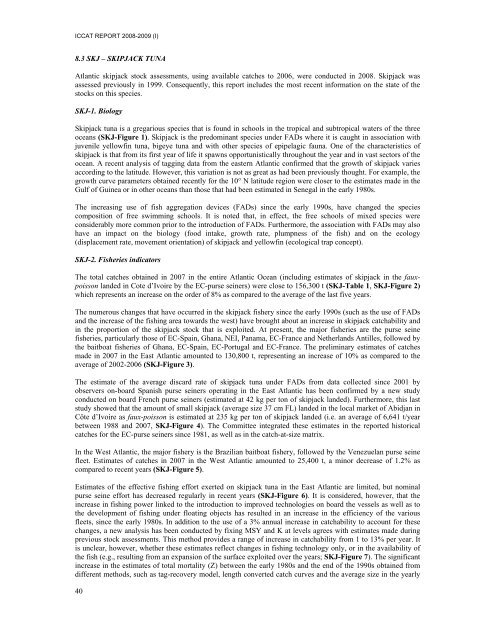REPORT OF THE STANDING COMMITTEE ON RESEARCH ... - Iccat
REPORT OF THE STANDING COMMITTEE ON RESEARCH ... - Iccat
REPORT OF THE STANDING COMMITTEE ON RESEARCH ... - Iccat
Create successful ePaper yourself
Turn your PDF publications into a flip-book with our unique Google optimized e-Paper software.
ICCAT <strong>REPORT</strong> 2008-2009 (I)8.3 SKJ – SKIPJACK TUNAAtlantic skipjack stock assessments, using available catches to 2006, were conducted in 2008. Skipjack wasassessed previously in 1999. Consequently, this report includes the most recent information on the state of thestocks on this species.SKJ-1. BiologySkipjack tuna is a gregarious species that is found in schools in the tropical and subtropical waters of the threeoceans (SKJ-Figure 1). Skipjack is the predominant species under FADs where it is caught in association withjuvenile yellowfin tuna, bigeye tuna and with other species of epipelagic fauna. One of the characteristics ofskipjack is that from its first year of life it spawns opportunistically throughout the year and in vast sectors of theocean. A recent analysis of tagging data from the eastern Atlantic confirmed that the growth of skipjack variesaccording to the latitude. However, this variation is not as great as had been previously thought. For example, thegrowth curve parameters obtained recently for the 10° N latitude region were closer to the estimates made in theGulf of Guinea or in other oceans than those that had been estimated in Senegal in the early 1980s.The increasing use of fish aggregation devices (FADs) since the early 1990s, have changed the speciescomposition of free swimming schools. It is noted that, in effect, the free schools of mixed species wereconsiderably more common prior to the introduction of FADs. Furthermore, the association with FADs may alsohave an impact on the biology (food intake, growth rate, plumpness of the fish) and on the ecology(displacement rate, movement orientation) of skipjack and yellowfin (ecological trap concept).SKJ-2. Fisheries indicatorsThe total catches obtained in 2007 in the entire Atlantic Ocean (including estimates of skipjack in the fauxpoissonlanded in Cote d’Ivoire by the EC-purse seiners) were close to 156,300 t (SKJ-Table 1, SKJ-Figure 2)which represents an increase on the order of 8% as compared to the average of the last five years.The numerous changes that have occurred in the skipjack fishery since the early 1990s (such as the use of FADsand the increase of the fishing area towards the west) have brought about an increase in skipjack catchability andin the proportion of the skipjack stock that is exploited. At present, the major fisheries are the purse seinefisheries, particularly those of EC-Spain, Ghana, NEI, Panama, EC-France and Netherlands Antilles, followed bythe baitboat fisheries of Ghana, EC-Spain, EC-Portugal and EC-France. The preliminary estimates of catchesmade in 2007 in the East Atlantic amounted to 130,800 t, representing an increase of 10% as compared to theaverage of 2002-2006 (SKJ-Figure 3).The estimate of the average discard rate of skipjack tuna under FADs from data collected since 2001 byobservers on-board Spanish purse seiners operating in the East Atlantic has been confirmed by a new studyconducted on board French purse seiners (estimated at 42 kg per ton of skipjack landed). Furthermore, this laststudy showed that the amount of small skipjack (average size 37 cm FL) landed in the local market of Abidjan inCôte d’Ivoire as faux-poisson is estimated at 235 kg per ton of skipjack landed (i.e. an average of 6,641 t/yearbetween 1988 and 2007, SKJ-Figure 4). The Committee integrated these estimates in the reported historicalcatches for the EC-purse seiners since 1981, as well as in the catch-at-size matrix.In the West Atlantic, the major fishery is the Brazilian baitboat fishery, followed by the Venezuelan purse seinefleet. Estimates of catches in 2007 in the West Atlantic amounted to 25,400 t, a minor decrease of 1.2% ascompared to recent years (SKJ-Figure 5).Estimates of the effective fishing effort exerted on skipjack tuna in the East Atlantic are limited, but nominalpurse seine effort has decreased regularly in recent years (SKJ-Figure 6). It is considered, however, that theincrease in fishing power linked to the introduction to improved technologies on board the vessels as well as tothe development of fishing under floating objects has resulted in an increase in the efficiency of the variousfleets, since the early 1980s. In addition to the use of a 3% annual increase in catchability to account for thesechanges, a new analysis has been conducted by fixing MSY and K at levels agrees with estimates made duringprevious stock assessments. This method provides a range of increase in catchability from 1 to 13% per year. Itis unclear, however, whether these estimates reflect changes in fishing technology only, or in the availability ofthe fish (e.g., resulting from an expansion of the surface exploited over the years; SKJ-Figure 7). The significantincrease in the estimates of total mortality (Z) between the early 1980s and the end of the 1990s obtained fromdifferent methods, such as tag-recovery model, length converted catch curves and the average size in the yearly40
















